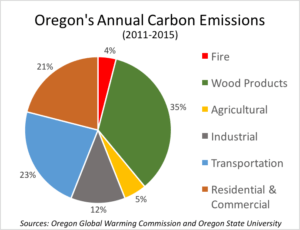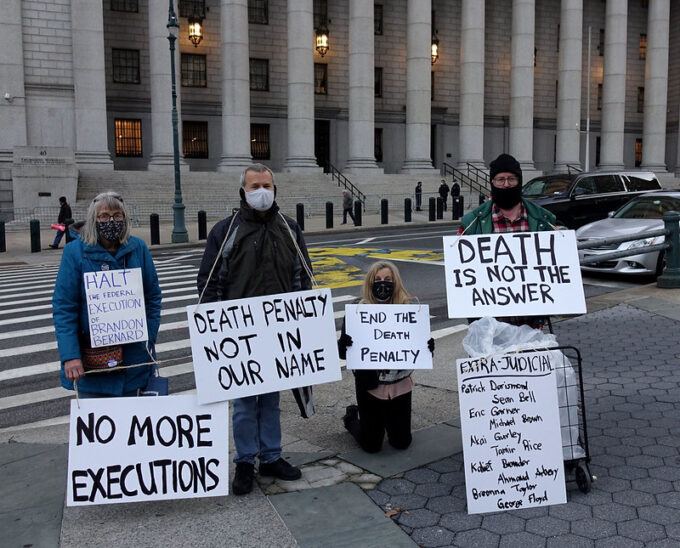
Biomass plant, Boardman, Oregon. Photo: Jeffrey St. Clair.
Presently around the West, the Forest Service, timber advocates, and far too many conservation organizations are promoting biofuels and biomass energy as “Green Energy.” The FS and its allies want to cut more wood (which they term fuels or “waste” while I call it wildlife habitat and carbon storage) from the forest and use it to produce some products that society values, like jet fuel or even heating buildings.
But the only thing “green” about biomass energy or fuel is the subsidies that government agencies bestow.
Those promoting the biomass fuel and energy juggernaut suggest that burning wood is “clean energy “and carbon neutral. However, biofuels and biomass energy are not clean, not carbon neutral, and not sustainable.
For instance, the City of Prineville, Oregon, promotes the construction of a 20 MW biomass burner. In their promotional literature, the city says: “The City and County will utilize the PREP to reduce the risk of severe wildfires, reinvent jobs in the natural resources/forest products industries, diversify energy supplies, reduce CO2 emissions, and reinvigorate the community and local economy, all while offering a clean, renewable energy source.”
In announcing its intention to construct biomass burners, Mount Bachelor Ski Resort makes the same happy talk about the benefits of wood-burning biomass.
And just this week in California, another biomass burner is about to be constructed in Birney–with the same delusional remarks about “clean” energy and how it will convert “waste” wood into electrical power.
Prineville, Mount Bachelor, and other promoters of biomass are feeding the public timber and biomass industry propaganda. I am sure they believe what they are saying but ignore contrary information.
SUBSIDIES AND ECONOMICS
Most biomass burners are not economical. They often receive massive subsidies of two kinds—direct funding from government agencies and the environmental damage they promote.
In most cases in the West, the wood source or “fuel” for biomass operations results from deforestation. These deforestation projects destroy biodiversity, pollute the land and air, and worsen climate change. And like almost all Forest Service logging projects, they also lose money, so they are yet another form of subsidy.
The other subsidies are direct grants and funding that biomass projects receive from government sources.
Recently the City of Prineville received a million-dollar grant from the Forest Service to help construct its proposed biomass burner.
The biomass burner being constructed in Burney, California received a $5 million dollar grant.
Like other projects, Mount Bachelor’s proposed biomass burner is subsidized with state and federal government grants. So why should taxpayers be funding a private business?
An even worse waste of tax dollars is the Red Rocks Biofuel plant in Lakeview, Oregon which has received over $350 million in public funding. Making these subsidies all the more disastrous is that the Red Rocks plant has never opened and recently went bankrupt.
The Red Rocks proposal was supported by a $75 million funding award from the Department of Defense, more than $2 million in infrastructure improvement from the town of Lakeview, and about $300 million in tax-exempt economic development bonds issued in 2018 through the state of Oregon. Unfortunately, all of these taxpayers and bondholders are losers.
The only good thing about the demise of the Red Rocks Biofuel project is that it means fewer trees will be logged to supply the plant with its biomas from the Fremont National Forest.
Due to the cost of transportation, cutting trees for wood burner operations typically is only economical for a 25–35-mile radius. Two things occur as a result.
First, biomass burners must bring fuel from more distant sources, which adds to their costs, often absorbed by ratepayers or government subsidies. The burner operations put more pressure on federal and state forests to provide more local fuel, which can lead to even more significant deforestation.
Furthermore, they remove funding from less polluting and destructive projects like distributed solar.
POLLUTION
Another problem with the moniker that biomass is “clean” is that they pollute the atmosphere with carbon and toxins that are damaging to health. Participant matter from burner emissions is continuous throughout the year rather than associated with one-time seasonal events like wildfires. People with asthma and other breathing issues are vulnerable to emissions.
Proponents argue that biomass burners operate at high temperatures that eliminate most toxins. But they don’t tell the public that during the start-up and shutdown phase, burners operate at far lower temperatures and emit significant amounts of pollutants during these periods.
Even worse for the atmosphere and human health is that biomass burners often consume the available nearby wood and then start to include building waste, railroad ties, tires, and other materials that contain numerous toxic materials in the mix.
WOOD IS AN INEFFICIENT ENERGY SOURCE
Because wood is less “energy dense” than alternatives from coal to natural gas, it requires more of it to produce the same amount of heat or “work” as producing electricity. So to get the same amount of energy for generators, wood-burning operations release far more carbon per unit of electrical power than alternative fuels. I’m not arguing that we should burn fossil fuels-we need to reduce all forms of carbon fuel sources, but believing that the substitution of wood is better than other fuels is misleading.
Researchers working with the Natural Resources Defense Council (NRDC) concluded that a wood-burning plant would have higher net carbon emissions than a comparable coal plant for the first 4 decades or more of operations.
The problem for society is that we must reduce all carbon emissions now. If the ice sheets melt in the next 20-30 years and flood places like Miami or New Orleans, it doesn’t matter if, in 40-50 years, burning wood might have less overall emissions (due to carbon capture by the new growth of trees over decades).
CARBON RELEASES
Logging the forest releases stored carbon. Industry shills suggest that burning wood is different from burning natural gas or other fossil fuels because it is “biogenic carbon,” meaning the growth of trees produces it, thus carbon “neutral.”
Logging in Oregon easily contributes far more carbon into the atmosphere than even the worse large blazes. Indeed, 35% of Oregon’s carbon is the result of logging.
An article in Earth Island Institute provides some clarity on wood and carbon. “About 28 percent of tree carbon is contained in branches, which is emitted when burned after logging operations. An additional 53 percent of the carbon in trees removed from forests is emitted as waste in the manufacturing and milling process. Overall, about two-thirds of the carbon in trees that are logged for lumber quickly become greenhouse gas emissions.” Since biomass operations burn an even greater amount of the tree (like branches), the amount of carbon released is significantly greater.

The green piece of the pie represents the amount of Carbon emissions from logging and wood products in Oregon.
However, this biocarbon has taken decades to centuries to accumulate but is released immediately when burned. Since most biomass operations use whole trees, they effectively release the bulk of all stored carbon.
Even a forest fire does not release most of the stored carbon. Instead, carbon remains on site as snags, down wood, roots in the ground, and charcoal. Though much of this may be released over time as decomposition occurs, it may take centuries to release all the available carbon in a tree.
FLAWED ASSUMPTIONS ABOUT “FUELS” AND FIRES
A further complication is that these projects, often subsidized by state and federal government grants, are based on flawed assumptions about logging projects on public lands. For example, most of these biomass proposals argue that we must reduce the density of trees on forestlands to eliminate or at least diminish major wildfires.
For instance, the city of Prineville, Oregon, is building a biomass burner using a grant from the Forest Service. Unfortunately, similar biomass burners or other facilities like biomass fuel production, including a plant by Lakeview, Oregon, are all heavily subsided by federal grants, not to mention the removal of wood from forest ecosystems.
All of these projects are using wood cut on national forest lands predicted on the premise that logging will preclude or slow wildfire spread and reduce carbon emissions. However, there is an abundance of scientific studies that present contrary evidence. Climate and weather are the primary drivers of large western blazes, not fuels.
For instance, in 2018, researchers from Oregon State University in Ecological Applications reported: “Daily fire weather was the most important predictor of fire severity, followed by stand age and ownership, followed by topographic features. Estimates of pre-fire forest biomass were not an important predictor of fire severity.”
They conclude: “Our findings suggest intensive plantation forestry characterized by young forests and spatially homogenized fuels, rather than pre-fire biomass, were significant drivers of wildfire severity.”
Similarly, another review paper that looked at 1500 fires in ponderosa pine and mixed conifer forests across the West concluded that active forest management (AKA logging) resulted in higher severity blazes than areas with no logging or other fuel treatments.
Plus logging emissions are far greater than those resulting from wildfires says OSU researcher Bev Law : “When you have a disturbance such as fire, and when wood is removed and harvested and put into wood products, you have to follow the carbon,” she said. “And it turns out that … harvest-related emissions are five to seven times that of the fire emissions in Oregon.”
PROFORESTATION
One of the best ways we can promote carbon storage is through trees. Proforestation provides a bridge for society that will allow us to move from burning fossil fuels to alternative energy sources (including simply energy conservation through the insulation of structures).
Merely allowing trees to mature and grow can store significant amounts of carbon are nearly no cost. The best use of our national forests is not for wood production but for carbon storage. Of course, this would also have ancillary benefits like providing wildlife habitat, preserving wildlands, and reducing government waste (currently going to promote biomass operations).
Bev Law of Oregon State University along with colleagues advocates creating strategic forest reserves to promote carbon storage and biodiversity protection.
As Bill Moomaw of Yale University suggests: “The most effective thing that we can do is to allow trees that are already planted, that are already growing, to continue growing to reach their full ecological potential, to store carbon, and develop a forest that has its full complement of environmental services,” said Moomaw. “Cutting trees to burn them is not a way to get there.”





